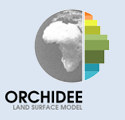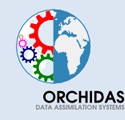



 |  |  |  | |||
| orchidas : Overview / | Site Map |
OVERVIEW
|
Description Various ORCHIDEE Data Assimilation Systems have been developed to optimize the ORCHIDEE model parameters within prescribed physical range (and given some uncertainties), using various data streams, in order to improve the simulation of the land surface fluxes of energy, water and carbon, as well as the carbon and water stocks, from regional to global scales. The different data assimilation systems rely on:
The main data streams that have been assimilated so far are:
Different numerical implementations of the model-data fusion have been implemented. They combine possibly several observational data streams to optimize the ORCHIDEE model parameters, using either:
Note that for the variational approach the gradient of J is estimated with the tangent linear model of ORCHIDEE, derived with TAF software (automatic differentiation tool), or for one application with YAO software (tool to facilitates the calculation of the adjoint model). |
| Last modified: 11/02/2018 22:22:45 |